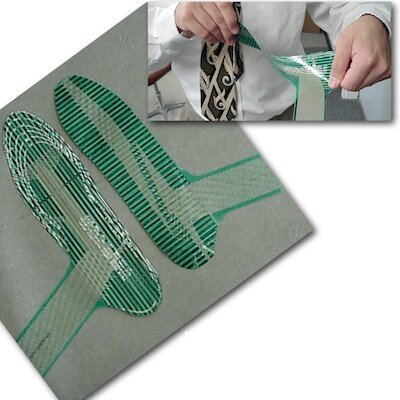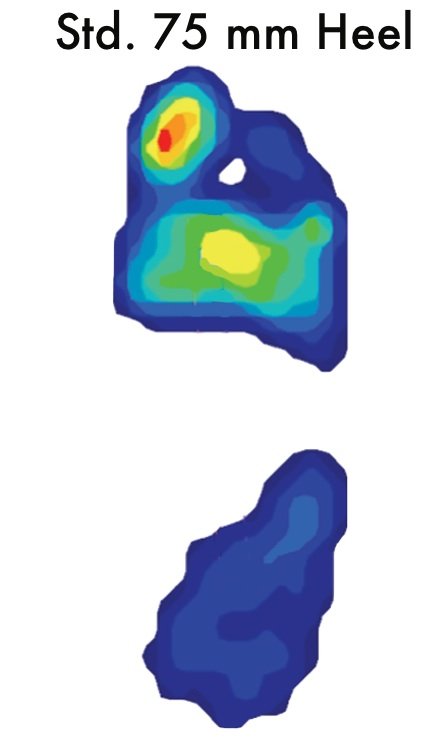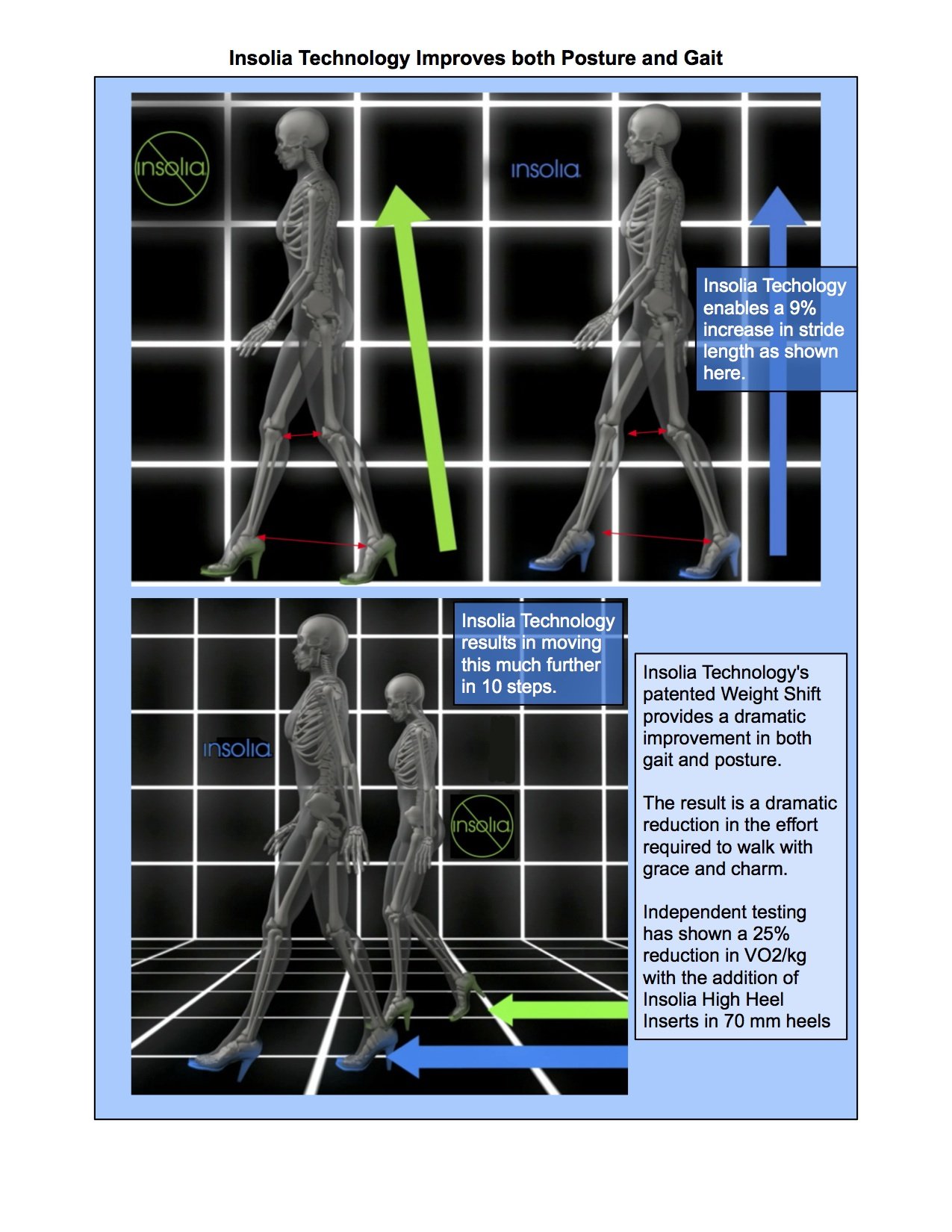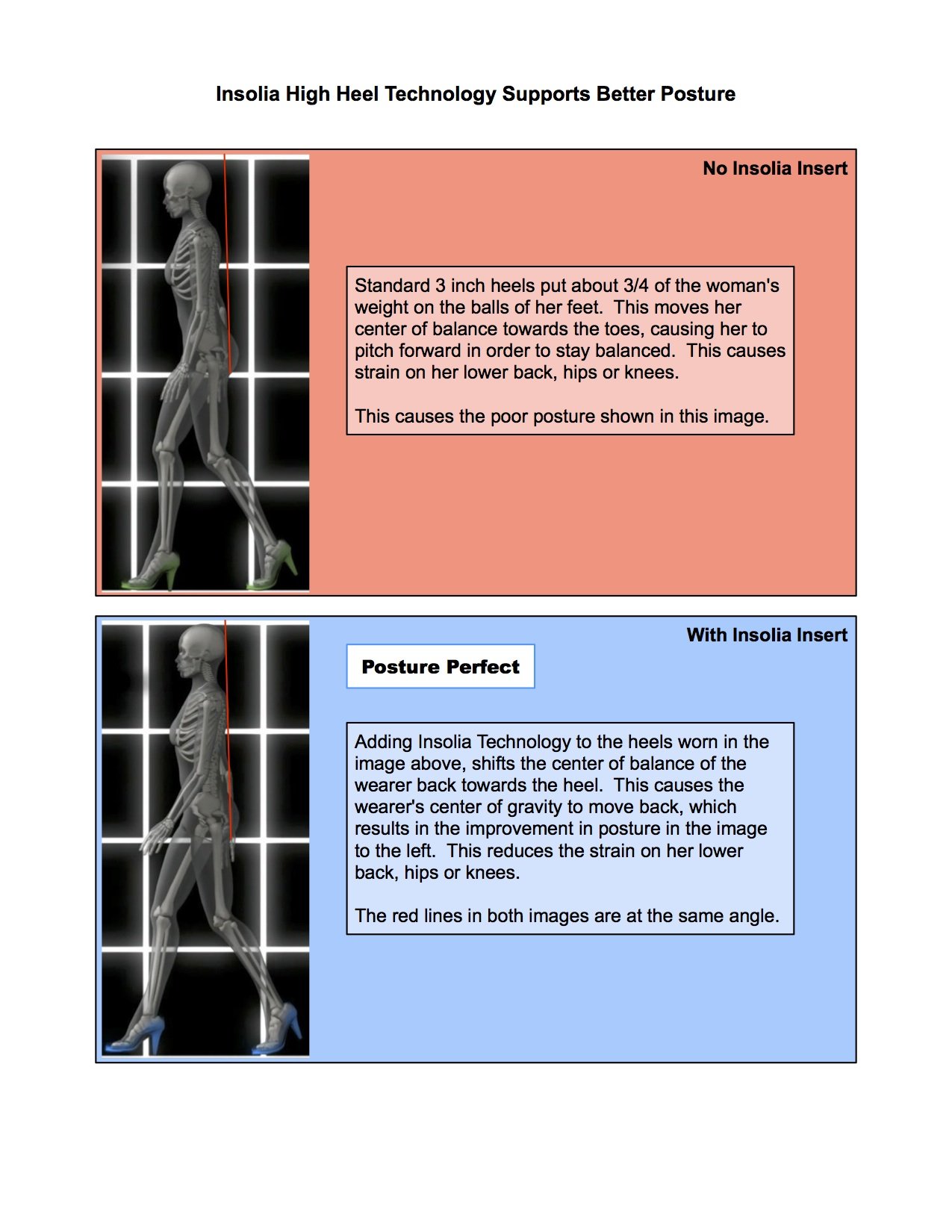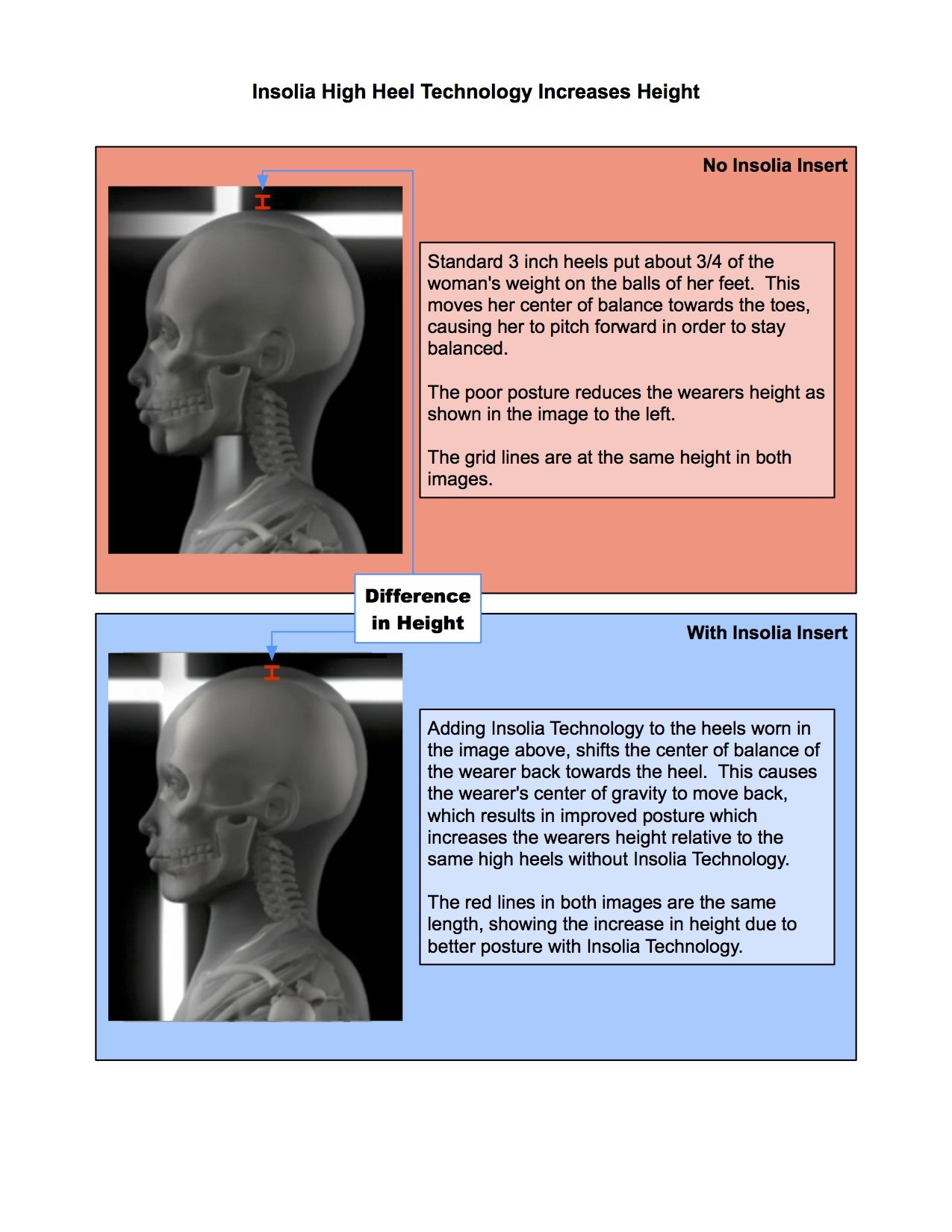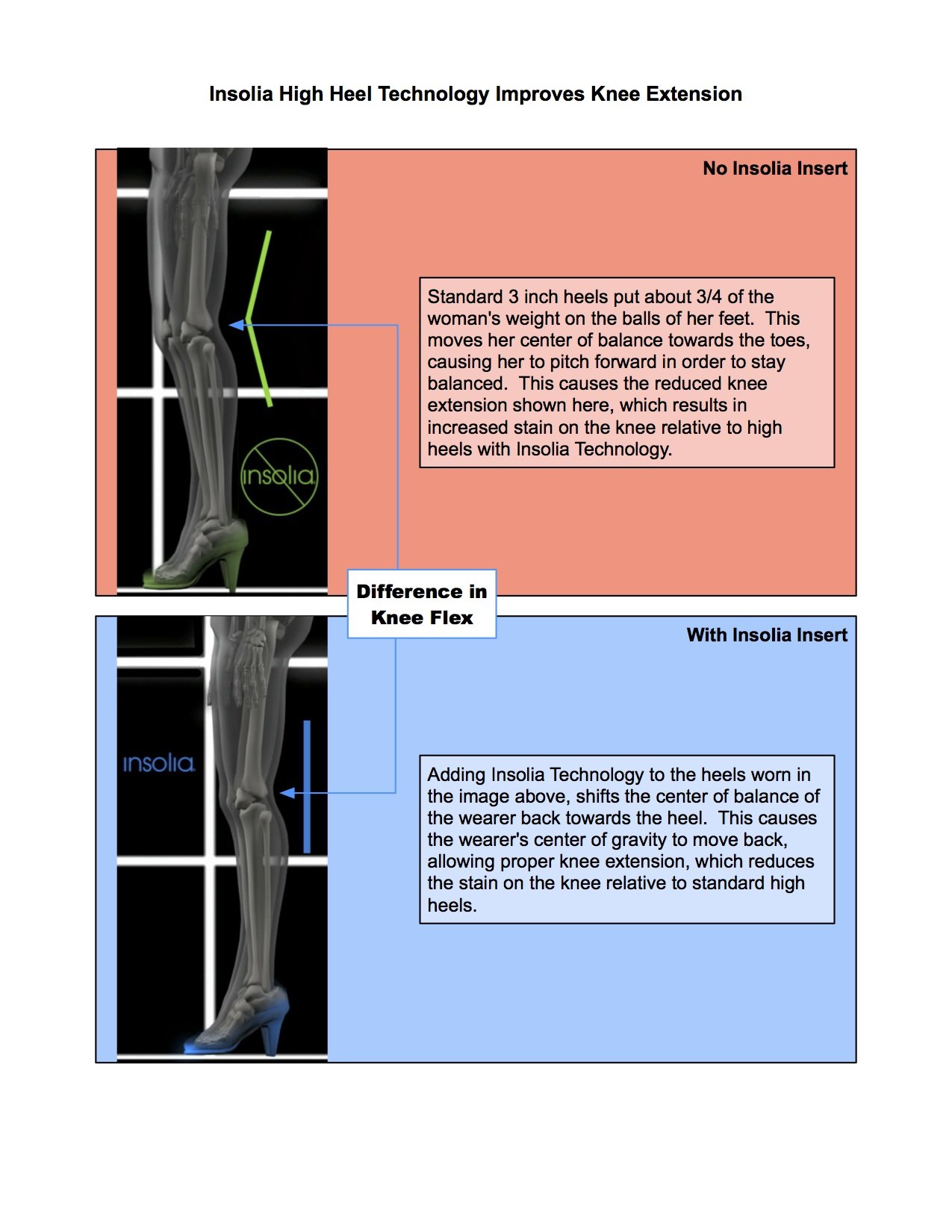Introduction & High Heel History
TekScan's F-Scan Sensors are used to capture in-shoe pressure data while standing and walking.
In the late 1980s, a female patient challenged Dr. Dananberg to make women's high-heeled shoes comfortable. Intrigued by this challenge, he began to study shoe making and learned that the basic design of a high-heeled shoe has not changed in hundreds of years. At the same time, he was receiving recognition for his work with in-shoe pressure analysis, a technology that gave him the ability to look inside the shoe and see how high heel shoes actually work during walking.
Dr. Dananberg learned that the design of high-heeled footwear shifted the wearer's weight and center of balance forward, and this was the root cause of the problems with high heels. Once he understood this, he was determined to find a solution to the problem.
Dr. Dananberg went to the streets of New York City and asked women about their love of high heels.
"I had to understand why women put themselves through the pain. What I learned was that women loved their high heels and would never stop wearing them. It became obvious that I could not change high heel styling to solve the problem. Any solution would have to be done on the inside of the shoe without any change to the outside or standard shoe construction."
After 500 years of living with the problem, it wasn't easy to find the solution. But with a combination of medical skill and modern thin film pressure sensing technology, he did just that.Understanding and solving the 500-year-old problem of high heel pain was Dr. Howard Dananberg’s foundational innovation that led to the creation of HBN Shoe in 1997. For its first three years, HBN attempted to design, produce, and sell a line of comfortable woman’s high heel shoes incorporating this technology. This proved to require extensive fashion design, footwear manufacturing, and footwear distribution expertise, which the Company did not possess.
Sandals designed by Bata Czech and marketed starting in 2002 incorporating the original Insolia Insole Board technology
In 2000, HBN’s strategy shifted toward selling and licensing this technology to shoe manufacturers, brands, and retailers worldwide. Over the next 18 months, the Company developed an implementation method utilizing an injection molded insole board incorporating Dr. Dananberg’s weight-shifting contours.
The original version of Insolia Heels was a molded insole board that incorporated Insolia weight shift technology and provided the structural support required in any high-heeled shoe. This complicated component was made from cellulose, steel, and injection molded plastic that required a vertical injection molding machine - most are horizontal. In order to meet the requirements for three shoe sizing standards, Asian, European, and UK/US, and to adjust the geometry for different heel heights, 131 different Insolia Insole Board design pairs were required to cover sizes equivalent to US Woman 6 to 10.
High-Heel Shoe Last and Matching Insolia Insole Board
The Insolia Insole Board cost over $2 per pair and required shoemakers to develop new lasts and construction methods. Even so, over a million pairs of high heels incorporating the Insolia Insole Board were produced and sold around the world.
The invention of the Insolia High-Heel Insert
In June 2004, HBN Shoe was at a crossroads. The company either had to make a significant investment in manufacturing capability to increase the production volume of the Insolia Insole Board, or it needed an alternative method to achieve the weight shift that the Insolia Insole Board provided.
Dr. Dananberg arrived at the June 2004 board meeting with a handmade prototype and presented his first design of a high-heel insert to the company. The Chairman, MIT-trained engineer Brian Hughes, offered to develop a quick prototype based on the hand-carved model. As Dr. Dananberg recalls, “Two weeks later, we gathered in my laboratory to see the outcome of Brian's work and conduct in-shoe pressure testing of the cast resin prototype. The results were extraordinary."
Test & Validation
In-Shoe Pressure Measurement
The pressure contour map shows what we discovered when we looked at 75 mm heels before and after we added Insolia Heels to the shoes.
In the “Std. 75 mm Heel” image, you can see that about 75% of this woman's weight is on the balls of her feet. This is why high heels cause so much discomfort and throw women's bodies and feet out of alignment.
In the “Insolia Heels Added” image, you can see what excited us so much the first time we saw it. Insolia Heels caused a third of the weight that was on her forefoot to be shifted back onto her heel!
We had restored proper weight distribution in three-inch heels.
That was a great day!
Engineering Evolution of Insolia Heels Technology
The Insolia High Heel Insert was a single material that could be manufactured by a standard horizontal injection molding machine. The new design fits the three shoe sizing standards, works in heel heights from 35mm to 90mm, and just four Insolia sizes cover US Woman size 4 to 12. Most significantly, it could be sold for less than a dollar, and could be added to existing styles of shoes, after lasting, with no change required to existing lasts.
This design also allowed us to develop a consumer aftermarket version of the product that could be added to the shoes already in a woman’s closet. (Vivian Lou is our direct-to-consumer reseller.)
Insolia Heels Engineering Evolution From Left to Right
A) First Hand Carved prototype - 2004.
B) Cast Resin Prototype was the part tested in the story above - 2004.
C) Insolia Heels® I-2 got it right and was launched in 2005.
(D) We launched a new version in 2016, the Insolia Heels® I-3, which added Insolia Cradle for better fit while increasing weight shift.
(E) Our current technology Insolia Heels® I-4, launched in 2019, incorporates everything we’ve learned about enhancing foot function and comfort. The refined Insolia Cradle with the added Insolia FlexPlus increased both standing and walking stability while enhancing weight shift.
Physiological Analysis of Insolia Heels
The Wales Centre for Podiatric Studies and the Centre for Biomedical Sciences, both at the University of Wales Institute in Cardiff in the U.K., undertook a study on the "Influence of High Heeled Footwear and Pre-fabricated Foot Orthoses on Energy Efficiency in Ambulation." We learned a tremendous amount from this independent study, and we have since made this kind of analysis part of our R&D methodology.
What they did was put "Ten healthy females (mean age 26.3 years, range 21 – 34) who were regular high heel wearers" onto a treadmill for 10 minutes and had them walk at 4.2 km/hour. While the women were walking, their breathing gases were tracked, as were their heart rates and the number of steps taken.
Once they had finished walking the 10 minutes, they were asked to rate various aspects of the comfort of the shoes by pointing to a 15 cm scale marked from 0 to 15, where 0 was "not comfortable at all,” and 15 was "the most comfortable condition imaginable.”
This data was then analyzed, and the statistically significant results are shown below and in the summary charts that follow.
Insolia Heels: Statistically Significant Results (P <0.05)
The Insolia Heels Effect on the 10 Women Tested in Shoes with 70 mm Heels for 10 minutes:
Metabolic Improvements with Insolia Heels vs. Standard
Reduced the average VO2/kg by 26%
Reduced the average number of steps by 13%
Reduced the average heart rate by 12%
Comfort Scale Improvements with Insolia Heels vs. Standard
Improved the average Forefoot Comfort score by 85%
Improved the average Overall Comfort score by 42%
Improved the average Heel Cushioning Comfort score by 28%
Click on any of the images below to enlarge them. You can move from slide to slide with the arrow keys or by swiping on your tablet. Hit ESC or the "X" in the upper right to return to this page.
We have often heard criticism that the extraordinary results we report must be due to the placebo effect. While that may be a factor in the subjective Comfort Scale, it can not be the reason for the dramatic reduction in oxygen (VO2/kg) when Insolia Heels were added to the test shoes. This is also true with the reduction in heart rate and in the number of steps taken. Insolia Heels made a significant difference in how these women walked, and as a result, they felt dramatic increases in perceived comfort.
3D Motion Capture (MoCap) Analysis of Insolia Heels
Anecdotally we could see that Insolia Heels appeared to improve a woman's posture in high heels. However, a customer asked if we could prove that Insolia Heels improved women’s posture. We'd seen a piece on the Dr. Oz TV show that used 3D motion capture to illustrate how badly a woman's gait was affected by high-heeled shoes.
We decided to try the same approach. We went to a motion capture company, and they fitted our model in a LED-encrusted body suit and fitted her heels with LEDs. She then walked back and forth, and multiple sensors and cameras captured her every move. We then added Insolia Heels to the same pair of shoes, and she repeated the process. Then the computers went to work, and this video is the result.
What we learned using the MoCap Motion Study
You can click on the five thumbnails below to learn more about what we discovered as we dived into the data the MoCap process generated.
As you'll see, we were able to document much more than a modest improvement in posture. The subtle differences in knee flex were only visible in a frame-by-frame analysis. The difference in how the foot landed, while obvious in retrospect, was noticed by reviewing the first computer images. The increase in height, again obvious in retrospect, was dramatically called out when we compared frames.
We were very pleased to be able to see the physical changes that produced the results in the Cardiff Wales study. We could see the increased stride length that resulted in a reduced number of steps. We could also see how the awkward gait and increased back strain in the test subject in standard heels would result in an elevated heart rate and increased oxygen demand. It is no surprise that removing these problems resulted in significantly increased comfort scores.
Click on any of the images below to enlarge them. You can move from slide to slide with the arrow keys or by swiping on your tablet. Hit ESC or the "X" in the upper right to return to this page.
Summary
The above is the story of how HBN Shoe came to be and how it solved the high-heel shoe problem.
The next step in our evolution was driven by market cycles. The women’s shoe business product mix changes from year to year. In some years, high heels are all the rage; in others, walking shoes or “flats” are just the ticket. This led us to work on novel products that would provide significant physiological benefits in a walking shoe.
That story is told in the section on Walking Shoes.
Our Intellectual Property strategy is discussed in the IP Summary section.

